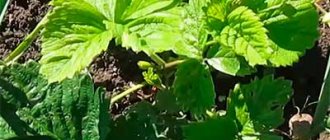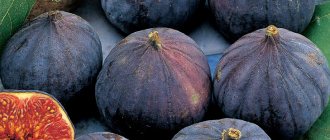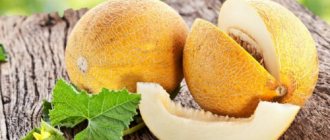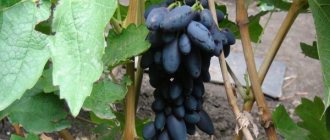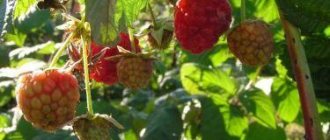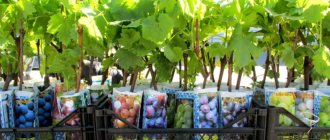“Torpedo” is considered one of the best varieties of melons. It is easily recognized by its impressive size, oblong shape and rich melon aroma. Despite its Uzbek roots, Torpedo is growing well in Russia. Let's learn how to plant and grow Uzbek melon in a temperate climate.
melon variety “Torpedo”
melon “Torpedo” juicy and sweet to the very crust
The ripe Torpedo melon spreads a delicious, sweetish aroma
Description of Torpedo melon
Varietal characteristics of “Torpedo”:
- oblong-shaped fruits;
- the crust is yellow, mottled with thin silvery veins;
- the pulp is white, juicy, has an oily consistency, thickness – 5-6 cm;
- There are many seeds inside the fruit.
The stems are strong and powerful. The shoots reach 2 m in length - they can be tied to supports.
"Torpeda", grown in Uzbekistan, has fruits up to half a meter in length.
Ripe Torpedo is easy to recognize by its aroma. This variety is characterized by increased aroma - the fruit exudes a specific melon aroma - delicate and sweetish.
About the variety
Central Asia is considered the birthplace of the Torpedo. In these countries they call it differently, for example, in Uzbekistan they call it “Mirzanchul”. By the way, Torpedo is also a popular name. Apparently, the melon was so nicknamed for its elongated shape, vaguely reminiscent of the projectile of the same name. We call this culture “Rainbow melon”, and it tastes a little different from the real Uzbek Torpedo. And this is not surprising, since the climate in our latitudes is not so hot, and, accordingly, the fruits are not so sweet.
Melon Torpedo is a late-ripening variety. In our latitudes, it takes at least 90 days for it to fully ripen. In Asian countries, where the climate is dry and hot, its fruits ripen faster - by mid-August. This variety is very heat-loving, and if it is grown in suitable conditions, the fruits can reach a weight of 10–15 kg. However, we rarely manage to grow pumpkin larger than 5 kg.
Externally, these melons are very attractive. Ripe fruits have an intense yellow color with thin white veins forming a reticulate pattern. The peel is dense, of medium thickness, resistant to damage, thanks to which the variety is well transported. The pulp is white, sweet, slightly oily, very juicy and aromatic.
The Torpedo variety is distinguished by powerful, intensively growing shoots. Young vines of plants grow over 2 meters, so supports are often built for bushes along which they weave. The yield of the variety is 2.5–3 kg per square meter.
Main characteristics
Fruits grown in temperate climates are smaller in weight and size than Uzbek “Torpedoes”. They are also inferior in taste to fruits grown in Asia.
Main characteristics of Torpedo melon:
| Characteristics/parameters | Description/meaning |
| Ripening time | late ripening, ripens no earlier than August |
| Achieving technical maturity | 60 days |
| Fruit weight | in Uzbekistan – up to 15 kg, in Russia – up to 5-7 kg |
| Transportability | excellent |
| Taste | excellent (but with a lack of sun the taste deteriorates) |
| Aroma | bright, rich, combines notes of pineapple, duchess and vanilla |
Fruits grown without harmful chemicals appear on the market no earlier than the end of August. Until this time, you should not buy oblong melons - they are either unripe or saturated with harmful additives that stimulate the growth of the crop.
An overview of the melon variety “Torpedo” is presented in the following video:
Harm and contraindications
The list of contraindications for eating melon is not too long. It is allowed in limited quantities for people with diabetes, albeit in the early stages. Torpedo melon fruits can be given from three years of age and even earlier, just try a little in small pieces.
It is not recommended to eat fruits:
- for gastritis, stomach ulcers;
- dysentery;
- with diabetes mellitus in severe forms;
- with a tendency to an allergic reaction in children;
- for bloating.
You should not eat Torpedo melon fruits with kefir or sour cream - there is a high probability of getting upset or indigestion. Also, doctors do not recommend eating Torpedo melon fruits with any alcoholic drinks or very cold water.
Advantages and disadvantages
Advantages:
- The fruits are well transported - melons can be transported over long distances without any problems.
- It can be grown not only in the south of Russia, but also in regions with a temperate climate.
- The fruits have remarkable product and taste characteristics.
- The fruits can be stored for a long time. In the basement or just in a cool room, “Torpedoes” can remain fresh and tasty until spring.
This wonderful variety has one drawback - the plant is demanding on growing conditions.
“Torpedo” needs warmth, and even better – sun, a lot of sun. This is what makes it so difficult to grow truly sweet melons in mid-latitudes. Unlike its main competitor, Kolkhoznitsa, it is not able to ripen completely in a temperate climate, and therefore does not reveal its true taste.
Chemical composition
Melon is very rich in valuable substances and microelements. For example, the rare vitamin PP. In addition to it, Torpedo contains vitamins A, B, E, and vitamin C, although in a small dose. The main share is carbohydrates - they contain up to 8 g, but the protein in the product is only 0.7 g, and even less fat - 0.2 g. Melons contain the most water - 70%, which is why it perfectly quenches thirst.
Record holders for the content of useful substances are Torpedo seeds. There are countless micro and macroelements in them. There is potassium, magnesium, silicon, iodine, fluorine, iron. The benefits of melon seeds for men are known - they are considered a powerful aphrodisiac. But for women and children, the fruits can be safely recommended for vitamin supplementation and general health.
Which is better to plant: seeds or seedlings?
In the southern regions, melon can be grown by simply sowing in the ground. This method of planting is permissible only in areas with warm summers, where a critical drop in temperature is excluded. In the temperate zone, melons planted in the ground do not have time to ripen, since planting takes place no earlier than May. So that melons have time to fill with sweetness, they are grown in greenhouses and hothouses.
Thus, the choice - seedlings or seeds - depends only on the climate. It is, of course, easier to grow melons by sowing them in the ground, but you have to tinker with the seedlings and then replant them in a permanent place. But there is no other way to grow Torpedo in a temperate climate.
When should you eat melon?
To achieve a preventive and healing effect, doctors recommend eating fresh melon in the following cases:
- to remove excess fluid from the body (has strong diuretic properties);
- to cleanse the intestines (due to the high fiber content, toxins are naturally removed from the body);
- to remove decay products of toxic substances;
- as a sedative and antidepressant;
- to remove bad cholesterol;
- in order to enhance the protective properties of the body.
Landing conditions
In order for melons to grow large and sweet, they need to be given a good start and optimal conditions for growth. Therefore, planting begins with the selection and preparation of a site.
Regionality
The ideal climate for growing this variety is hot and dry. The further north you go, the less weight the fruits have, and the less sweetness they contain. “Torpedo” can be grown in a temperate continental climate, but only in seedlings or even in a greenhouse.
Temperature
Melon is extremely thermophilic; for growth and development it needs a temperature regime that excludes a drop to 15°C. In order for the planted seeds to develop, they need a daytime temperature of 20-25°C, and a night temperature of up to 15°C.
Lighting
Melons need an unshaded area open to the sun - this is the main condition for fruit growth. In greenhouses for crops, additional artificial lighting with an intensity of 5-6 thousand lux can be provided.
Soil composition
The soils for melon beds are selected to be fertile. In the fall, organic matter is added to the open ground - humus or compost, mineral fertilizers. Optimal acidity is neutral, the best soils are chernozems and sandy loams. The soil must be dug up and loosened.
Composition of soil for planting melons:
- peat – 15%;
- sand – 25%;
- humus – 50%.
How to grow your own
The Torpedo variety is grown in two ways: seedlings and without seedlings. The first is suitable for regions with short summers and sudden weather changes; the second is for warm and temperate climates. Let's look at each method in detail and learn the secrets of growing.
Landing
A necessary preparation step is disinfection. Seeds are disinfected using aloe juice, Bordeaux mixture, and succinic acid solution. The seed material is soaked for 24 hours and then placed in a damp cloth for germination. Germination shows the germination of seeds and increases their immunity.
Then do one of the following:
- In the seedling method, seeds are planted in prepared soil in any convenient container (flower pot, plastic cups, peat tablets). Grow seedlings for 2-3 weeks in a warm and sunny place. It is recommended to keep it near the battery or on the windowsill. Water the seedlings as the soil dries out, only with warm water. When transplanting into the garden, the sprouts are carefully placed in dug up and cleared of debris beds.
- With the seedless method, the seeds are immediately planted in the garden after disinfection. First, the soil is dug up and fertilized with liquid manure or vermiculite, a mineral substance that increases germination. During the first week after planting, each sprout is covered with polyethylene to protect it from winds and cold temperatures. Melon loves a mixture of sandy and loamy soils, so it is important to choose the right planting site.
The basis of any care is timely and competent watering. Moisten the beds once every 5–7 days only with warm water (optimal temperature is about +18 °C). 2 liters are consumed per bush. If the summer is hot and rainy, the amount of water is reduced.
Once every 2 weeks, instead of regular water, use an infusion of burdock or nettle. They protect against diseases and prevent the development of weeds. Before each watering, it is recommended to loosen the soil so that the water gets as deep into the roots as possible.
The second element of healthy melon development is the organization of fertilizing. Both organic substances and mineral complexes are used. Fertilize the Torpedo variety once every 10 days.
Preference is given to the following fertilizers:
- dry wood ash;
- liquid bird droppings;
- urea;
- superphosphate;
- monopotassium phosphate;
- mineral complex "Kimira";
- growth stimulants “Kornevin” or “Heteroauxin”;
- spraying with whey solution.
Important ! Don't forget about loosening and removing weeds. These procedures make the soil more nutritious and lighter, protect against pests and maintain healthy microflora in the beds. Loosening is carried out once a week. The recommended depth is 10–15 cm.
Features of cultivation and possible difficulties
In the northern regions of the country, Torpedo melon is grown mainly in greenhouses or greenhouses . Polycarbonate structures are excellent. They are lightweight, transmit sunlight, affordable and easy to install. Before planting in the greenhouse, all hard surfaces are disinfected with a solution of potassium permanganate. The structure is characterized by heat and high humidity, so it is important to monitor the condition of the ground. The greenhouse is ventilated daily by opening the windows.
A mandatory procedure is the formation of bushes and pinching the tops. As soon as 5 leaves appear, the shoot above the fourth leaf is removed. In the future, it is important to leave two main shoots above each leaf, no more.
Growing methods
In the south, it is not customary to tie up melons; they grow excellently, stretched out over loose melon fields. The fruits ripen lying directly on the soil - in hot and dry climates they do not require any shelter or backing plywood. A temperate climate, with its lack of sun and high humidity, is a different matter. To protect melons from rotting, special growing methods are used, more about them below.
In spread
This is the usual way of growing melons. Fruits and shoots spread freely along the melon patch. The gardener's task is to increase productivity. To do this, the main shoot is pinched above the 4th leaf, and the side shoots - two pieces - are not touched. The remaining shoots are fixed on the ground, stimulating the formation of additional roots.
Pinching shoots allows you to usefully redirect nutrients - they go not to leaves and shoots, but to fruits.
On trellises
Growing melons on trellises is a labor-intensive method that is usually used in greenhouses. In open ground, trellis growing is used as a last resort - if there is a critical shortage of planting space.
How trellis growing is organized:
- At a distance of 2 m from the ground, stretch 2 wires or ropes stretched between two supports.
- The shoots, as the seedlings grow, are tied to trellises. The first shoot is to the wire located on the left, the second - to the opposite one.
The garter method used ensures optimal illumination of the shoots. You only have to tie up the plant the first time. When it gets stronger, it will begin to braid the ropes on its own.
Recommendations for selection
To ensure that the treat does not cause harm, it must be chosen correctly. Torpedo melon will only be useful if it was grown without excessive amounts of pesticides and nitrates, so you should not buy it before its natural ripening period - mid-August or even early September. When choosing a fruit, you need to take into account other nuances in order to buy a tasty product:
A ripe melon should have a uniform yellow rind. If the skin is orange, it means there was excess urea in the soil. Greenish spots on the peel indicate the immaturity of the fruit. Greenish streaks are considered a sign of high nitrate content, while dark spots indicate that the product has begun to deteriorate. The peel should also be free of mechanical damage.
- The ripeness of “Torpedo” can be determined by the elasticity of the peel. For a good fruit, it should be springy and bend easily if you press on it. It is advisable to tap the skin - if the sound is dull, it means the product is ripe.
- A quality vegetable should have a thick and dry tail. If it is green, it means the fruit is not yet ripe. The nose part should be a little soft to the touch.
- The melon should have a pleasant smell even when uncut. Its absence, combined with juicy and shiny skin, indicates an excess of fertilizers during cultivation.
- It is not recommended to buy cut fruits or products lying on the ground next to the highway.
When cut, the pulp should have no white veins or a green stripe under the skin. They talk about the immaturity of the fetus. In this case, the seeds should be yellow in color and easily separated from the pulp. If the melon tastes bitter or bland, it means the product is spoiled and it is not recommended to eat it.
If the purchased melon turns out to be unripe, do not be upset. It should be placed in a dry, warm room, since in such conditions it will be able to fully ripen.
Sowing rules
There is nothing complicated in sowing melons, but there are rules, without which you cannot hope for good fruits and a large harvest. You need to select good seeds, prepare them, and sow them correctly.
Seed selection and preparation
When buying melon seeds, it is important to pay attention to the shelf life. If you prepare the seeds yourself, you should choose the largest seeds.
Seed preparation activities:
- Examination. The seeds are immersed in water. The good ones sink to the bottom, the dummies float to the surface.
- Etching. The seeds are wrapped in gauze and dipped in a slightly pink solution of potassium permanganate. Stand for 6 hours. Potassium permanganate can be replaced by zinc sulfate or boric acid. But then the etching takes twice as long.
- Warming up. The seeds are placed in a sunny place or in the oven, where the temperature is set at 40-50 degrees. Warm up for 3-4 hours.
- Growth stimulator. To make the seeds hatch faster, a growth stimulator is added to the potassium permanganate solution.
- Hardening. The immunity of seeds is increased by soaking in warm water, followed by exposure at different temperatures - first at room temperature, then at 0°C.
- Germination. They are sprouted in damp sawdust or gauze moistened with water. The seeds hatch and a sprout appears. The seeds are ready for planting - in cups or in open ground.
To plant melons in open ground, take seeds collected 3-4 years ago. Last year's seeds are infertile; only male flowers will grow on the plants.
Melon seeds remain viable for up to eight years.
Sowing scheme and timing
The depth of planting seeds in open ground is up to 5 cm. Different sowing schemes are used, but there should be at least 60 cm between adjacent recesses. 4-6 seeds are placed in each hole. At the same time as the seeds, add fertilizer - 1 tsp. nitrophoska or a handful of humus.
Typically, the sowing scheme in open ground is selected taking into account the climate. “Torpedo”, as a late-ripening variety, is sown according to the same pattern in the steppe and forest-steppe zones - 140x140 cm.
Seeds are sown from the beginning of May, focusing on the local climate and current temperature conditions. This is especially important for sowing in open ground. If you sow the seeds too early, the first return frost will destroy the seedlings. But you can’t be late either - the melons must have time to ripen. Considering that the ripening period for Torpedo melon is 2 months, the last sowing date is mid-July.
Sowing seedlings
In the middle zone, melon is sown for seedlings from mid-March to the end of April. Sowing order:
- Prepare peat pots (d=10 cm).
- Fill the pots with soil. You can buy a ready-made substrate for seedlings, or you can prepare the soil mixture yourself:
- soil – 1 part;
- humus - 3 parts;
- nitrogen and potassium fertilizers - 1 tbsp. l.;
- phosphorus fertilizers – 3 tbsp. l.
- Place 2-3 seeds in each pot. Planting depth is 1.5 cm. Don’t forget to warm up the seeds before sowing.
- Provide lighting for the seedlings - they should be in the light for at least 12 hours a day.
- Before planting, feed the seedlings twice. The first time is 10 days after sowing. It is best to use complex fertilizers.
- When shoots appear, leave the strongest one and remove the rest.
The minimum temperature for germination is + 23°C, for seedling growth + 21°C.
Planting seedlings in open ground
Seedlings are planted in the ground at the age of 25-35 days. This is done a little later than sowing in open ground, since you need to wait until the threat of frost completely disappears. Seedlings can be used both for planting in a greenhouse and in open ground.
The order of planting seedlings:
- Water the pots with seedlings to make it easier to extract the soil with roots. Your task is to do this as carefully as possible without damaging the roots.
- Dig holes for the seedlings. There should be about 1 m between them. Mix humus and compost with warm water - pour this mixture into the holes.
- Move the seedlings into the prepared holes. Place it so that the root collar is at soil level.
- For the first 2-3 days, protect the plantings from direct sun.
Never grow melons in one place for more than two years if you do not want to be left without a harvest.
How to choose fruits when purchasing
When choosing a Torpedo in a store or on the market, it is important to pay attention to the appearance. The melon should be large and firm, without scratches or other damage . A characteristic sign of maturity is a dull sound when tapped .
Aroma is also of great importance. The ripe one has a strong characteristic odor; if it is not there, it means the fruit is not yet ripe. The tail should be hard and dry.
Important ! Be careful when purchasing from roadside stalls. Often the fruits lie on bare ground, which is why they can become infected with dangerous infections. Eating such melon can lead to poisoning.
How to properly care for your Torpedo?
Melon is a powerful and viable crop, capable of producing huge fruits that are unusually large and tasty. But for this she needs certain conditions. How sweet and large the melons will grow depends on the efforts of the gardener.
Neglect of care can end disastrously for the crop - if the plants do not dry out or wither from thirst and lack of food, then diseases and pests will destroy it. Let's find out how to care for the Torpedo.
Regularity of watering
The amount of watering depends on the climate, current weather conditions, the growing method and the growing season. Features of watering melon:
- If the melon is sown in open ground. Plantings are watered starting from the moment of sowing so that seedlings appear faster. The plantation is watered about 5 times every week - if there is no rain. Watering rate – 45 liters per 1 sq. m. The second important stage for watering is from the emergence of seedlings to the formation of ovaries. During this period, the roots of the plant have not yet penetrated deep enough into the soil, so it needs artificial irrigation.
- If the melon is planted with seedlings. Water the plantings as the soil dries out. Overmoistening is not acceptable.
- A month before harvesting, watering is stopped - otherwise the fruits will be unsweetened and watery, but most importantly, they will crack.
To water melons, use only warm water heated to a temperature of 20-25°C.
Thinning and loosening
When sowing seeds in open ground, the seedlings are thinned out twice:
- when the first leaf blooms;
- after blooming 3-4 leaves.
There should be 1-2 of the strongest plants left in the hole. When thinning, the soil is loosened, trying not to affect the area near the seedlings - so as not to damage the roots. During the growing season, melon plantings are loosened approximately 3-4 times. Loosening depth – 8-10 cm.
When and what to feed?
Melon plantings are fertilized 2-3 times during the growing season. Fertilizing is especially important when growing melons in open ground. The first is carried out when the first leaf appears. Then the plants are fed
Scheme and composition of fertilizing when growing melon in seedlings:
| When to deposit? | What to fertilize with? |
| Planting seedlings in the ground in mid-May, when the plant has its first 4 leaves | humus or vermicompost |
| 10 days after landing | application of nitrogen fertilizers - 20 g of ammonium nitrate per bucket of water |
| In another week | humus, ash or chicken manure solution |
| A week later | repeat of previous feeding |
In the fall, during plowing, phosphorus and potassium fertilizers are applied, and in the spring, nitrogen fertilizers are applied. Do not apply too much nitrogen fertilizer, otherwise the crop will overgrow.
Melon loves potassium most of all. If there is enough of it, the plant blooms well, does not get sick, and the ovaries and fruits are actively forming. Melons come out sweet and ripen quickly. All one-component fertilizers are diluted in water.
If fertilizer is applied at the root, take a bucket of water:
- superphosphate – 50 g;
- ammonium nitrate – 15 g;
- potassium chloride – 30 g.
Pinching and removing ovaries
In the middle zone, the formation of melon bushes is a particularly important event, on which the yield depends. In order for the fruits to be large and have time to ripen, it is necessary to limit their number on the bush.
Features of the formation of Torpedo bushes:
- There should only be 2-3 shoots left on one plant.
- The main stem is pinched when 3-4 fruits have formed.
- The tops of the left side shoots are also pinched.
- When the diameter of the fruit reaches 5-6 cm, remove all excess ovaries.
- On one plant, depending on its strength, 3-6 of the largest fruits are left. Climatic conditions are also taken into account - the shorter and cooler the summer, the fewer fruits the bush can “feed”.
Use in cosmetology
Torpedo melon is popular in masks and creams. The beneficial properties of this ingredient are used in professional cosmetology. It is included in creams that prevent the appearance of early wrinkles, whitening masks, moisturizing shampoos and hair balms.
Read also: How to preserve watermelon until the New Year at home
At home, melon pulp can be used to whiten freckles and age spots on the face. It is also applied to nails to reduce their fragility. To moisturize the skin of the face, lips or hands, fresh pulp is mixed with olive oil and applied in a thin layer. After using such masks, the skin becomes matte, the color evens out, softness and velvety appear. To strengthen the hair, burdock oil and egg yolk are added to the ground pulp. To restore the structure of blow-dried hair, this mask should be done once a week for a month.
Homemade melon masks should be washed off with warm water.
Diseases and pests
In temperate climates, the main danger for melons is high humidity. Too damp soils and humid air are undesirable for southern culture - it is attacked by bacterial, viral and fungal diseases. If the Torpedo is overwatered, root rot rapidly develops.
Diseases of Torpedo melon and measures to combat them:
| Diseases | Symptoms | Treatment |
| Anthracnose | Pink or brown spots appear on the leaves. Then there are torn holes, the leaves turn yellow and dry. The fruits rot and become deformed. | Spraying with 1% Bordeaux mixture. |
| Root rot | Roots rot with poor care and high humidity. The color of the stems and roots changes, they become thinner. There are dark spots inside the fruits. | Properly water and loosen row spacing. Treat the seeds in 40% formaldehyde for 5 minutes. |
| Fusarium wilt | The leaves become light and spotted. Within a week the plant dies. | The plant is sprayed during budding with a solution of potassium chloride. |
| Powdery mildew | A whitish coating appears on the leaves, then they turn brown and become brittle | Spraying every 11 days with sulfur powder 80% (per 1 hundred square meters - 350 g). Spraying is stopped 3 weeks before harvest. |
Prevention measures for all melon diseases:
- seed dressing;
- soil disinfection;
- compliance with crop rotation.
If infection occurs and the infection is detected, the melons are treated with a 1% copper sulfate solution. If this does not help, you have to select a specialized fungicide.
The risk of insect damage is reduced if the beds are cleared of weeds and the humidity is moderate. But if pests do attack the melon beds, you have to use a suitable insecticide for the specific type of pest.
Torpedo melon pests and measures to combat them:
| Pests | What harm? | How to fight? |
| Melon fly, | The fly lays its eggs directly into the fruit, while it gnaws through the skin to get to the pulp. The larvae feed on fruit juice. | Biological and chemical preparations are used. Sprayed with Mikosan, Fitoverm, Actofit and others. |
| Spider mite | They live on the inside of leaves. Plant development is inhibited. Losing juice, the bushes dry out. | Preparations containing phosphorus and sulfur or acaricides are used. |
| melon aphid | The juices are sucked out of the leaves, they curl and dry out. | If there are aphids on the melon plant, it is treated:
|
The melon fly is one of the most dangerous pests of melons and melons. The pest is capable of destroying half the crop.
How to eat melon correctly
Melon is an independent dish. It cannot be eaten on an empty stomach. At least 2 hours should pass from the main meal, and at least 30 minutes after. When combined with other products, melon will begin to ferment in the stomach, causing bloating and gas formation.
A particularly bad idea is to combine melon with alcohol, wash it down with cold water or milk. This may cause poisoning.
Before use, the fruit should be washed with soap and wiped dry. Use only a clean knife.
If dark spots are found on the flesh after cutting, it is better to discard the whole melon. She's spoiled. Removing the affected areas will not help - any piece can cause poisoning.
Torpedo melon is tasty, sweet, with a unique aroma. But the best fruits reach the shelves from Central Asia; in order not to get green or spoiled, you need to choose it correctly.
Determination of ripeness
If you pick a melon ahead of time before it has reached commercial ripeness, it will not taste good. Such fruits, when ripened, will not acquire a good taste. Moreover, they will take on the smell of acetone.
Classification of melon ripeness stages:
- Commercially mature. Fruits collected at the stage of biological ripeness;
- Green mature. They are collected at the stage of technical ripeness - ripening occurs during storage.
- Technical. Fruits that have reached milky ripeness. They are used for canning and pickling.
- Non-commodity. Sent for animal feed.
How to determine the ripeness of a melon right in the beds:
- The fruit has acquired a typical varietal color. For Torpedo it is a rich yellow color. A characteristic mesh pattern appears.
- The fruit has a sweet smell. It is especially felt if you lightly rub the skin of the fruit.
- Melons are easily torn from the stems. And she herself becomes lethargic and shrunken.
- The peel is neither soft nor hard, but moderately springy.
- When lightly tapping the fruit, a dull sound is heard.
You can calculate the approximate time of ripening by counting 90 days from the moment of emergence.
What you need to pay attention to when choosing a Torpedo melon is described in the video below:
Useful properties of Torpedoes
Melon Torpedo will benefit not only healthy people, but also those suffering from various diseases.
The fiber contained in the sweet berry helps cleanse the intestines of waste, toxins, and decay products. Enzymes stimulate metabolic processes and help normalize the functioning of the digestive organs.
Fruits saturate the body with vitamins and nutrients, prevent the occurrence of vitamin deficiency, anemia, and various diseases associated with a lack of microelements in the body. Ascorbic acid strengthens the immune system and helps to recover faster from various colds.
It is useful to eat melons after operations. The pulp stabilizes the nervous system, helps normalize blood counts, and helps a weakened body recover faster. It is also useful for bladder diseases, since it contains a large amount of water and has a diuretic effect.
The fruits contain substances that help get rid of depression. Melon improves mood and performance.
The berry is useful for women. Regular use will help prolong youth, improve the condition of the skin, nails and hair.
Harvest and storage
Fruits intended for food or sale are harvested at the market ripeness stage. Pumpkins are beautiful, yellow, and exude a melon aroma. Such fruits are not suitable for long-term storage. They can last no more than 2 months.
If the melon is intended to be stored, it is picked at the stage of technical maturity. “Torpedo” refers to varieties that tolerate storage well. This late-ripening melon has excellent shelf life and, if favorable conditions are created, can be stored for up to six months.
Tips for picking melons:
- Pick the fruits together with the stalk. There should be a “tail” of about 3 cm.
- Harvest melons early in the morning or evening. You can't pick melons in hot weather.
- Leave the melons on the site for 3-4 days. Turn the fruits every 5-6 hours.
Requirements for the room in which melons will be stored:
- Cool. The room should be cool, but not cold. The optimal temperature for melons is + 2…+4°C. Optimal humidity is 80%.
- Disinfected. Can be treated with bleach or smoke bombs. After treatment, the room should remain closed for 4-5 days.
- Ventilated. After keeping the room closed, it is ventilated.
- Whitewash. All wooden elements are whitened with freshly slaked lime.
In storage, the fruits are placed on shelves sprinkled with sawdust or chaff. The second storage method is hanging. Each fruit is placed in a coarse mesh and then tied to a crossbar.
It is prohibited to store melon near potatoes and apples. Potatoes give it an unpleasant taste, and the fruits begin to rot. Apples emit ethylene, which accelerates the ripening process - melons become overripe. The fruits are periodically inspected; if they notice that the fruit has spoiled, it is immediately removed.
Growing Asian melons in temperate climates once seemed impossible. Today, thanks to special agricultural technology, the use of seedlings and covering methods, it is possible to grow the famous “Torpedo” weighing up to 5 kg here.
0
0
Copy link
Time and place of purchase
Melon ripening begins in August. Therefore, there is no need to rush and purchase fruit at the beginning of summer. Fruits that go on sale before the last month of summer are not distinguished by their sweetness. Often their taste is not natural. They often contain harmful components, since in order to obtain a harvest ahead of schedule, melons are treated with growth stimulants in high concentrations.
It is important to choose the right place to buy. It is better to purchase melon from a supermarket, official market or store. In such places, the storage conditions for products are observed. Therefore, the likelihood of poisoning from spoiled fruits is much lower.
You cannot buy melons at spontaneous retail outlets, which in summer are often found along busy roads. The fruits sold there constantly absorb harmful substances. In addition, they lie directly on the ground in violation of all sanitary standards.
The skin of the melon is not dense. Therefore, before purchasing, the fruit is carefully inspected to ensure that there are no cracks, stains, dents or other damage. Do not buy a cut melon and do not allow the seller to cut it. The pulp contains a lot of sugar. Therefore, once cut, it becomes an ideal breeding ground for bacteria.
